What gear do you need for a Precision Rifle match?
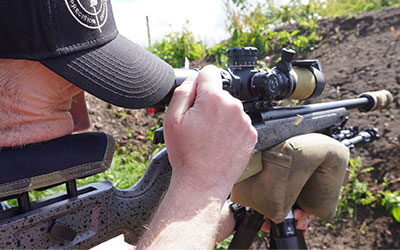
What gear do you need for a Precision Rifle match?
The sport of Precision Rifle is unique amongst other target shooting sports and requires participants to have at their disposal equipment that is either purpose made for the sport, or which can be repurposed from other shooting disciplines.
Over the short span of years that Precision Rifle has grown in popularity, many manufacturers have brought to the market innovative equipment and gear solutions that aid Precision Rifle shooters in maximising their results.
Whilst investment in the sport is a good thing, there is now so much equipment out there that it can be overwhelming for the new shooter. The equipment is not inexpensive, its purpose may not be immediately obvious and how to use it may be a mystery. Working out what you need can be challenging.
If we are to draw up a list of what equipment a Precision Rifle shooter needs those lists may look different depending on the competitor’s level of experience and competence. For example, someone who has not shot a match before may not benefit (in fact they may be hampered) by using a tripod for rear support, whereas a seasoned competitor would see a tripod as essential to their ongoing success at the top of the sport.
The good news is, to get started, you don’t need a lot of kit.
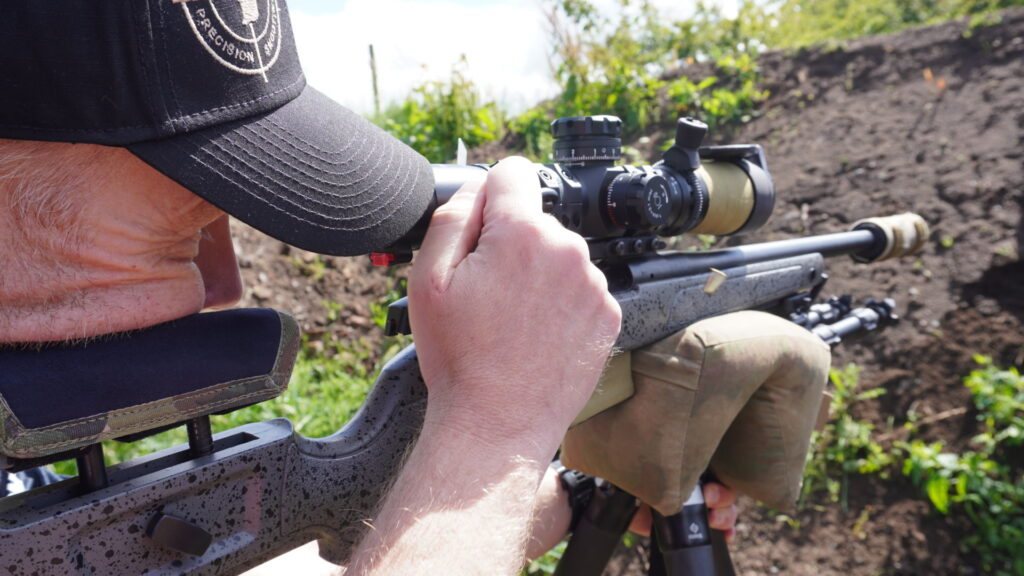
Shooting off a barricade bag. You don’t need a lot of gear to get started. Your rifle and a few key pieces of kit, such as a barricade bag, a bipod and a ten-round magazine, will have you shooting a match in no time.
The following gear checklist is organised for the new shooter.
What gear do I need to get started in Precision Rifle?
First up, the essentials.
- Ear protection
- Chamber flag
- Rifle
- Scope
- Ammunition
- Magazine
- Bipod
- Barricade bag
- Sharpie pen or pencil
- Something to carry it all in
Safety first. Ear protection is essential and should always be worn when at a match. Ear plugs will provide ample protection, but electronic ear defenders are preferable as they allow you to hear instructions from RO’s and interact easily with your fellow competitors. A chamber flag is a requirement at all matches so that you can show, and it can be seen, that your rifle is clear when you are not on the firing point.
You will need a rifle, scope and ammunition. It should be a bolt action rifle you are familiar with and have data for elevation drop out to approximately 1000 meters. The ammunition you use should be suitable for shooting out to 1000 meters and not exceed competition requirements for muzzle velocity (check this with the match organiser). 6.5 creedmoor is a popular calibre. It is a great round to start with for those new to the sport and continues to be used by the best competitors worldwide.
Your scope, ideally, should be variable power (5-25 is popular) and have a reticle in the first focal plane (ffp) with sub-tensions that match the turrets: MIL/MIL or MOA/MOA. The majority of shooters will use Milliradians, and you should consider joining them, especially if you are buying a new scope specifically for Precision Rifle. It is worth making the switch to Milliradians but if your current scope is MOA and you don’t want to get a new one, you’ll be good. Your scope should have an exposed elevation turret because dialling your elevation, rather than holding, is preferable when you have the time. If you want to dial for wind, use a scope with an exposed windage turret too.
Ideally, you want a detachable magazine with at least a ten-round capacity.
You can, of course, shoot a match with a hunting rifle that has an internal magazine capacity limited to three rounds and a fixed power scope in the second focal plane. If that’s what you’ve got, bring it! You’ll make hits on steel and no doubt have a great time, but your potential will be limited, and you will quickly realise that you need a rifle system more attuned to the competition environment, such as that offered by the B14 HMR, HMR Pro or the BMP, and there are a couple more pieces of essentials that all Precision Rifle shooters will have in their kit…
A bipod. Great for shooting prone, which you will always be asked to do at a Precision Rifle match on at least one stage, and for resting your rifle on the ground (pointing in a safe direction) when waiting for your turn to shoot.
A barricade bag. On the majority of stages at a match you will be shooting off some sort of prop, such as a tank trap or a purpose-built barricade or a feature of the natural landscape, like a tree stump or a rock. A barricade bag filled with a pliant material that can conform to whatever prop you encounter and provide support to the fore-end of your rifle for stable shots is a basic requirement. Your barricade bag can also double as a rear bag when you are shooting prone.
A pen or pencil, for making stage notes and recording scores.
As you’ll be moving from stage to stage as the match proceeds, you will need something to carry your kit in, such as a rifle bag with pockets or a rucksack.
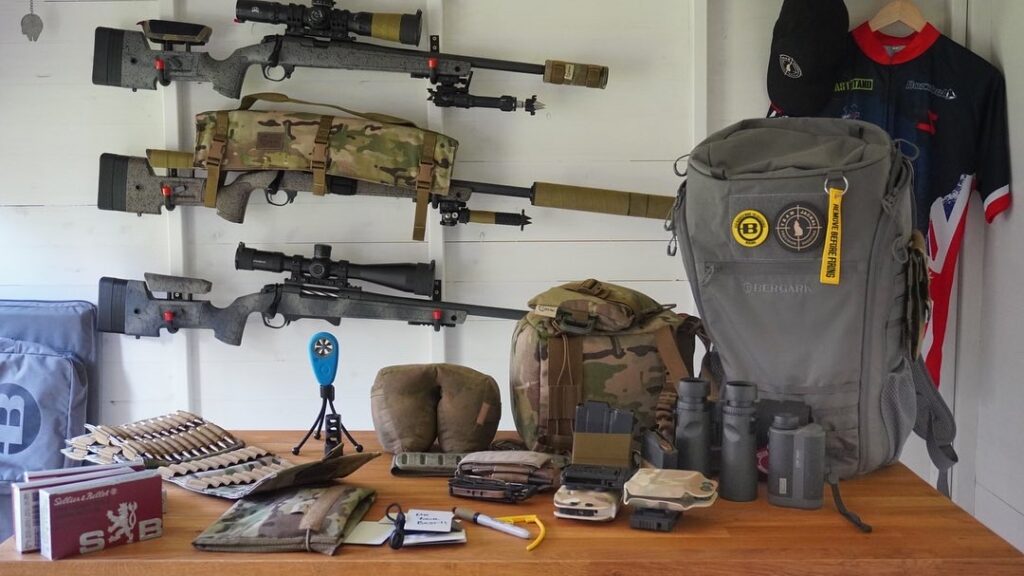
A basic Precision Rifle load out. If you know your dope out to 1000 yards you can start shooting.
Gear you will quickly want to invest in
- Muzzle brake or moderator (suppressor)
- Dope card or arm coach
- Weather meter (such as a Kestral)
- Ballistics calculator
- Binoculars or spotting scope
- Range finder
A typical one-day match might consist of anywhere up to ten stages and 100 rounds. With an average of ten rounds per stage you want to make sure you can see where your first round is hitting or missing so you can correct your follow up shots and maximise your hit percentage. Nothing will aid you better in this regard than using a muzzle brake or, to a lesser extent, a moderator. Though I know people who shoot matches without using a muzzle brake or moderator it is a limiting factor. Being able to reduce recoil so that you can stay on target and see where your bullet goes is a massive aid to performance.
Dope card or arm coach. On some stages you may have to engage targets from multiple positions out to multiple distances. Under the pressure of match conditions, the clock ticking down, you would be best placed to record this information in an easily accessible place, such as on your arm or your scope, so if you forget which position to move to or which target to engage or what elevation to dial or hold for, you can quickly reference it.
A weather meter is very handy for assessing the wind speed and direction at the firing point and, when paired with a ballistics calculator, for gathering environmental data. Measurement of temperature, humidity and pressure (altitude) combine to give the Density Altitude at your location. Feed the Density Altitude into a ballistics calculator and you can have precise data for your elevation adjustments.
Weather meters are a great piece of kit to have, especially when they are self-contained units that include a ballistics calculator, such as the Kestral Elite, however, they only provide a wind reading at the firing point and not across the hundreds of meters between you and your target so you’ll need to have a way of observing what’s happening down range, which is why, if you don’t already own a set, you’ll eventually want to invest in a pair of binoculars or a spotting scope.
At most matches you will be given the Course of Fire which will include ranges to targets in both yards and meters. You may choose, however, to verify those distances using your own range finder. That way you won’t fall foul of errors made by others, and you are ensuring that distances are measured using the same equipment you yourself have used when ‘doping’ your rifle and ammunition.
It is also the case that some matches require the shooter to find and range all or some targets themselves, therefore, a good set of binos and a range finder would quickly move on to the list of essential gear. Though I’ve not encountered this myself, there are also some stages (they seem popular in Scandinavian countries) that require you to measure a known size target with your reticle and calculate distance to target without the support of electronics, so you might want to invest in learning some basic maths formulas. There is a lot of variety in the sport of Precision Rifle.

Preparing for a Precision Rifle match. A strong rucksack to carry all your gear in is high on the list of essential equipment but some kit, like an ammo book, are more a luxury than a necessity, though they do make for a more comfortable match day experience.
Equipment you will advance towards as your ability grows
- Cuddle bag
- Tripod
- Arca rail
When we shoot prone or off a bench, we find we can support the front and the back of the rifle with ease for a very stable, wobble free shot. The weight of the rife is fully rested on the ground or bench, usually connected with a bipod or bag at the front and a bag at the rear. Inputs from the shooter are minimal. When taking a typical shot in Precision Rifle, only the front of the rifle, forward of the mag-well, will be supported and the rear of the rifle must be supported by the shooter. The shooter may be seated, kneeling, standing or contorted into a position that stresses the muscles. Competitors have found ways to combat the wobble inducing positions they are asked to shoot in. They train and find innovative solutions with the gear they use. Two such gear solutions are the cuddle bag and the tripod.
The cuddle bag (picture a square, oversized pillow made of cordura or a similar tough wearing material) is a versatile piece of kit that can be sat or laid on or which can fill the space between the shooters trigger arm and their body. It can also be used as a rear rest. Essentially, it stabilises the shooter and therefore the rear of the rifle to reduce the ‘wobble zone’.
The cuddle bag about to come into action. All your Precision Rifle equipment needs to be practiced with or you risk it getting in your way when it matters.
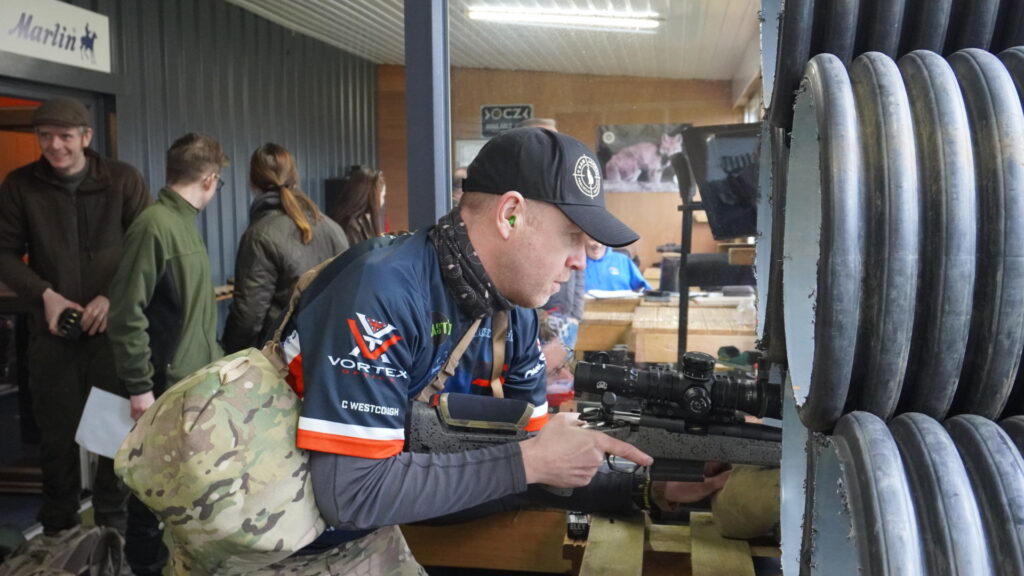
A tripod, used at the rear of the rifle, can firmly transfer the weight of the rifle to the ground and, when used correctly, eliminate any wobble. Where the stage allows, a tripod can also be used at the front of the rifle in the place of shooting from a bipod, bag or prop.
The drawback with cuddle bags, tripods, or other non-essential gear items is that they bring complexity. It can be challenging enough to manoeuvre your rifle and barricade bag when up against the clock without having to worrying about an additional piece of kit. The tripod in particular needs practice because they often have to be deployed on the clock and are awkward to move in to and between positions. Which brings us nicely on to Arca rails.
Arca rails (used extensively by photographers, as are tripods) found their way into Precision Rifle when competitors realised they could be of benefit in a number of ways. An Arca Rail, running the full length or part of a rifle’s fore-end, provides the shooter with a means to mount and dismount different shooting accessories quickly and in a position on the rifle’s fore-end appropriate to the obstacle in front of them. They also provide a great means to attach something to your rifle, such as a barricade bag, so that you can move your rifle and the accessory as one and keep your other hand free for moving additional pieces of gear, such as a rear support tripod.
Arca rails show us that the sport of Precision Rifle, much like Formula 1 racing, is driving innovation in equipment development like no other shooting discipline.
What’s your thoughts about equipment for Precision Rifle?
The above list is not exhaustive yet covers the main aids to performance that will typically be utilised by a competitive shooter. Some equipment is not listed here, like an ammo book, which could be considered a luxury item, and we’ve not covered tools for rifle maintenance or the practice of carrying spare parts in case of a breakdown.
Do you carry a full tool kit to a match or a slimmed down version of the essentials? Maybe you carry a spare trigger in your kit? What piece of kit is essential to you at a match that I have not listed?
I’d like to hear your thoughts about anything written here and your recommendations for Precision Rifle equipment at [email protected]
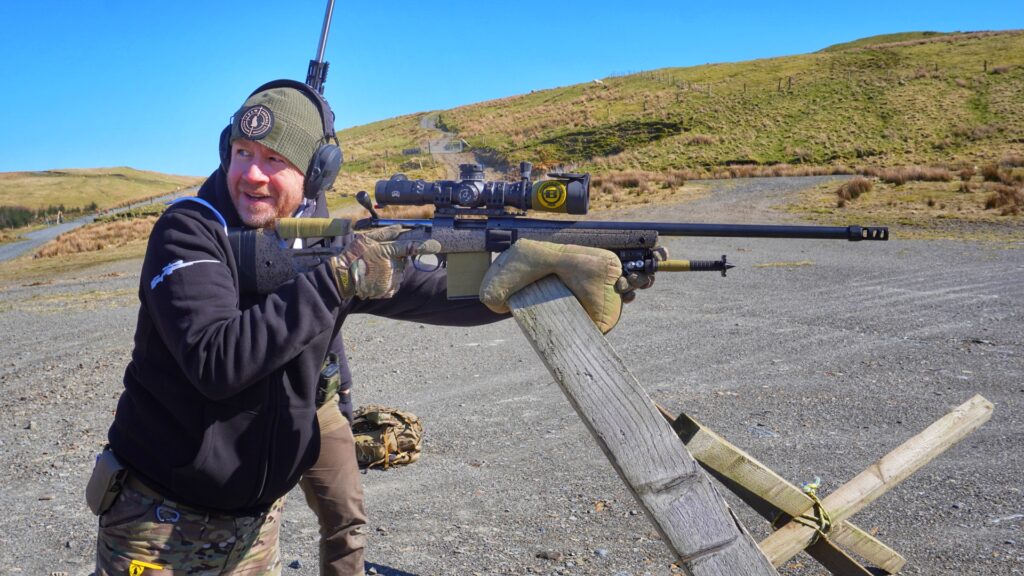
Equipment recommendations from the Bergara line up
Here at Bergara we have some rifle and gear options that we think are perfect for Precision Rifle and which our own Pro Team use:
- Rifle – either the B14 HMR, HMR Pro or BMP
- Muzzle Brake – the TP1 or ST1 (barrel thread pitch dependent) three port self-timing muzzle brakes
- AICS 10 Round Magazine
- 20 or 30moa picatinny scope base (not mentioned on the list above because you may not require a base that provides you with extra elevation adjustment in your scope, but if your rifle system would benefit from one, we have it covered)
- Fore-end picatinny rail for mounting of a bipod with Quick Detach (QD) clamp (again, not covered above, however, the ability to quickly attach and remove your bipod is recommended and this can’t be achieved if you have your bipod attached to a sling swivel)
- Bergara Double Gun Case or Bergara Gun Case 130cm and the Bergara EDC 25 Backpack or Daypack 35L
Don’t let not having the gear listed above hold you back from getting involved in Precision Rifle. You will struggle to find a competition anywhere in the world where you will not be provided, either by the event organiser or a fellow shooter, with any of the gear you will need or would like to try at a match. Come with what you have and borrow the rest. Try out other people’s gear. See what you like, what works for you and then, when ready, buy your own.
About the Author
Christian Westcough is a Bergara Rifles international pro team member from the United Kingdom. He is also the media officer for both the IPRF (International Precision Rifle Federation) and the GBPRA (GB Precision Rifle Association) in the UK and shoots competitively for Team Jackal.
If you have any questions pertaining to this blog article or questions about precision rifle shooting, feel free to send an email to [email protected]
You can also follow Christian on his social media account.
Instagram: @guerrier_weg
